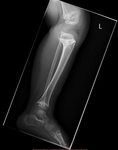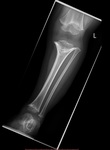Keywords:
Performed at one institution, Observational, Retrospective, Arthritides, Diagnostic procedure, Digital radiography, CT, Bones, Anatomy, Paediatric
Authors:
C. E. O'Brien, C. Ní Leidhin, J. Duignan, A. C. O'Brien, R. Hayes; Dublin/IE
DOI:
10.26044/ecr2020/C-01498
Purpose
Premature growth plate fusion and associated limb length discrepancy is a cause of morbidity in the paediatric population. Appearances and causes are variable and presentation is often temporally remote to the initial insult. Children frequently present to the orthopaedic service with leg length discrepancy. The purpose of this study was to review the causes of non-traumatic premature fusion of growth plates in children to and identity the most common patterns of injury on plain film radiographs.
Bone growth and expansion occurs almost exclusively at the growth plates in children and the growth plates usually remain open until the age of 12-14 in girls and 13-15 in boys. Any insult here can lead to early arrest of limb lengthening with subsequent limb length discrepancy. The most frequently reported cause of premature fusion is trauma (1), (2). The only other series published in the literature in the last 30 years discussing the causes of growth plate arrest attributed 72% of cases to trauma alone, 8 associated with infection (10%), 7 associated with Blount disease (9%) and 9% associated with other miscellaneous causes(1) .
The imaging features that are associated with premature fusion of growth plate on plain film radiograph include physeal bony bridges connecting the secondary ossification centre (SOC) to the metaphysis which progresses to irregularity and asymmetry of the growth plate as the unaffected aspect of the growth plate continues to lengthen. The size and location of the growth arrest is important for assessment, prognostication and treatment planning. Treatment can be surgical or non-surgical, with nonsurgical treatment usually reserved for patients who are nearing skeletal maturity, cases where less than 30% of the plate is affected and where the central plate predominates (3) If the abnormality is detected early surgical treatments include removal of the bony bar and interposition of inert material such as fat, silastic or metacrylate (4), bilateral epiphysiodesis to prevent limb length discrepancy and limb lengthening(5). Early detection of growth plate fusion is vital to allow the optimal treatment and prevent morbidity. Patients who have suffered trauma, and who are at risk of premature fusion, may be under imaging follow up allowing earlier detection of fusion. However other causes of growth plate fusion may be more difficult to detect and require careful scrutiny of radiographs to minimise delay to diagnosis and treatment.
We investigate the causes and review the most common patterns of injury on plain film radiographs



